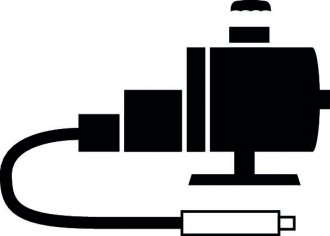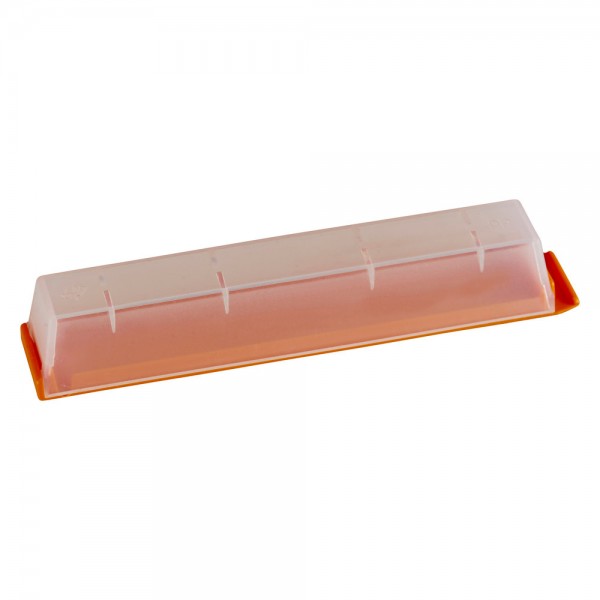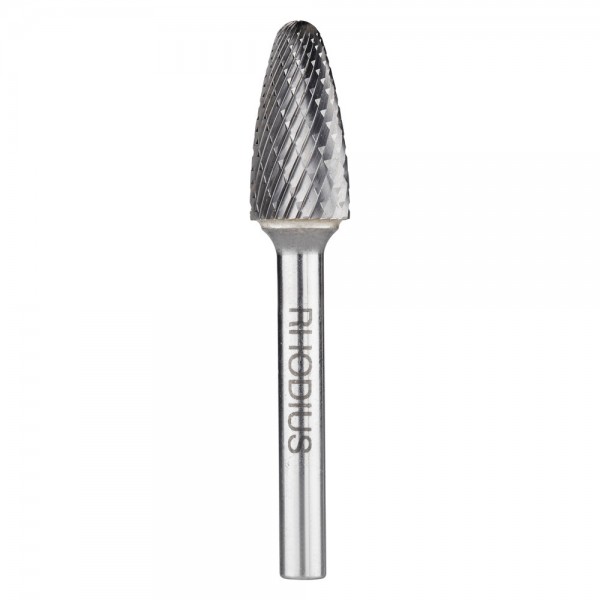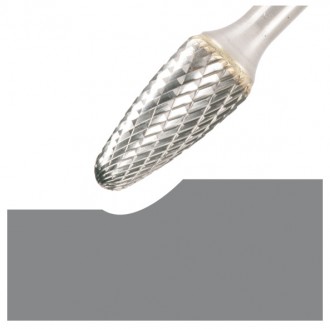HF F TOP
HF F TOP
Content: 1 Unit
Prices incl. VAT plus shipping costs
- Order number: 305048
- Please select your desired product variant here:
Carbide burr, shape F (RBF): ball-nosed tree.
Machine suitability:
The HF F tungsten carbide burr can be used with straight grinders, flexible shaft drive machines and air grinders. The recommended cutting speed is 450–600 m/min for unalloyed steels/cast steels/cast iron, and 250–350 m/min for alloyed steels/tool steels/rust- and acid-proofed steels. The recommended cutting speed for aluminium and other non-ferrous metals such as copper, brass and bronze, as well as plastics, is 700–900 m/min.
Structure and production:
The head is attached using a specialised brazing technique, while the teeth are cut using high-precision diamond discs on advanced CNC machines. This technique ensures an optimum and high-performance cutting geometry.
Quality:
The HF F provides users with the best RHODIUS tool in its category. RHODIUS TOPline products represent a maximum level of performance and quality.
Applications:
With this carbide burr in the single cut variant (Z 3), the user benefits both from aggressive stock removal as well as a long tool life and concentricity. The double cut variant with chip breaker (Z 6) also enables highly aggressive stock removal combined with a long tool life and concentricity. A very high surface treatment quality is also achieved. The variant featuring a special aluminium cut with large teeth and polished facets (Z ALU) also achieves excellent stock removal performance. Deposition of the working material in the chip spaces is also kept to a minimum here. With especially long-chipping materials such as soft aluminium, the use of cutting oil, paraffin or grease continues to be recommended in order to keep the negative effects of clogging to an absolute minimum.
Dimensions:
The carbide burr with shape F (ball-nosed tree) according to DIN 8032 is available with head diameters of 3 mm to 16 mm. The shaft diameter is 3 mm or 6 mm.
Notice:
Special variants with shaft lengths of up to 400 mm are available for this tungsten carbide burr.
• Maximum concentricity
• Perfectly coordinated cutting geometry ensures top-quality working results
• Maximum lifetime
Machine suitability:
The HF F tungsten carbide burr can be used with straight grinders, flexible shaft drive machines and air grinders. The recommended cutting speed is 450–600 m/min for unalloyed steels/cast steels/cast iron, and 250–350 m/min for alloyed steels/tool steels/rust- and acid-proofed steels. The recommended cutting speed for aluminium and other non-ferrous metals such as copper, brass and bronze, as well as plastics, is 700–900 m/min.
Structure and production:
The head is attached using a specialised brazing technique, while the teeth are cut using high-precision diamond discs on advanced CNC machines. This technique ensures an optimum and high-performance cutting geometry.
Quality:
The HF F provides users with the best RHODIUS tool in its category. RHODIUS TOPline products represent a maximum level of performance and quality.
Applications:
With this carbide burr in the single cut variant (Z 3), the user benefits both from aggressive stock removal as well as a long tool life and concentricity. The double cut variant with chip breaker (Z 6) also enables highly aggressive stock removal combined with a long tool life and concentricity. A very high surface treatment quality is also achieved. The variant featuring a special aluminium cut with large teeth and polished facets (Z ALU) also achieves excellent stock removal performance. Deposition of the working material in the chip spaces is also kept to a minimum here. With especially long-chipping materials such as soft aluminium, the use of cutting oil, paraffin or grease continues to be recommended in order to keep the negative effects of clogging to an absolute minimum.
Dimensions:
The carbide burr with shape F (ball-nosed tree) according to DIN 8032 is available with head diameters of 3 mm to 16 mm. The shaft diameter is 3 mm or 6 mm.
Notice:
Special variants with shaft lengths of up to 400 mm are available for this tungsten carbide burr.
Properties:
Quality:

Thickness:
 DIN shape for tungsten carbide burrs
DIN shape for tungsten carbide burrs Material suitability:
 Stainless steel
Stainless steel  Steel
Steel  Non-ferrous metals
Non-ferrous metals  Cast iron
Cast iron Machine suitability:
 Straight grinder
Straight grinder  Air grinder
Air grinder Product variants:
| Product dimensions | Cut | Content | Article no. | Product category number | GTIN barcode packing unit |
|---|---|---|---|---|---|
| 3 x 14,0 x 3,0 x 38 | Z 6 | 1 | 305048 | PK09 | 4011890077924 |
| 6 x 18,0 x 6,0 x 50 | Z ALU | 1 | 305050 | PK09 | 4011890077948 |
| 6 x 18,0 x 6,0 x 50 | Z 6 | 1 | 305051 | PK09 | 4011890077955 |
| 8 x 20,0 x 6,0 x 65 | Z 6 | 1 | 305052 | PK09 | 4011890077962 |
| 8 x 20,0 x 6,0 x 65 | Z 3 | 1 | 305697 | PK09 | 4011890087220 |
| 9,6 x 19,0 x 6,0 x 64 | Z ALU | 1 | 305053 | PK09 | 4011890077979 |
| 9,6 x 19,0 x 6,0 x 64 | Z 6 | 1 | 305054 | PK09 | 4011890077986 |
| 9,6 x 19,0 x 6,0 x 64 | Z 3 | 1 | 305698 | PK09 | 4011890087237 |
| 12,7 x 25,0 x 6,0 x 70 | Z ALU | 1 | 305055 | PK09 | 4011890077993 |
| 12,7 x 25,0 x 6,0 x 70 | Z 6 | 1 | 305056 | PK09 | 4011890078006 |
| 12,7 x 25,0 x 6,0 x 70 | Z 3 | 1 | 305699 | PK09 | 4011890087244 |
| 16 x 25,0 x 6,0 x 70 | Z 6 | 1 | 305057 | PK09 | 4011890078013 |
| 16 x 25,0 x 6,0 x 70 | Z 3 | 1 | 305700 | PK09 | 4011890087251 |








